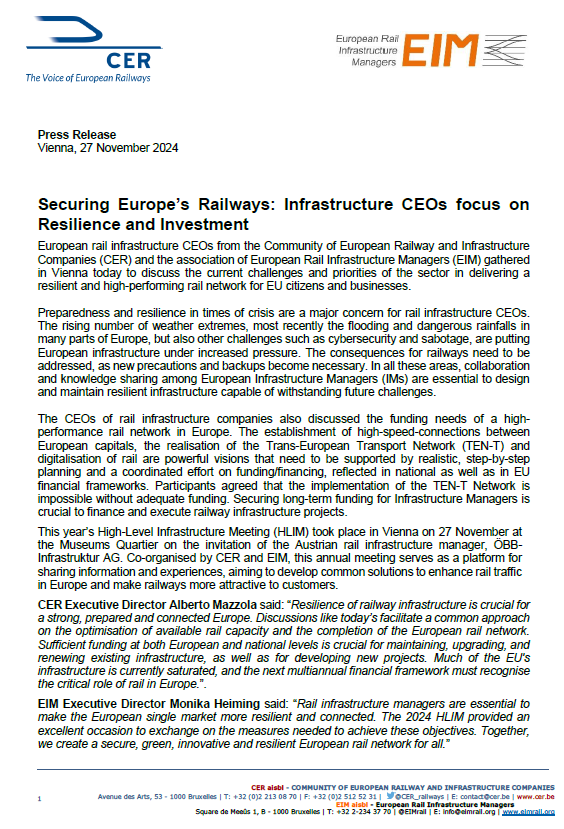Press Releases
European rail infrastructure CEOs from the Community of European Railway and Infrastructure Companies (CER) and the association of European Rail Infrastructure Managers (EIM) gathered in Vienna today to discuss the current challenges and priorities of the sector in delivering a resilient and high-performing rail network for EU citizens and businesses.
Preparedness and resilience in times of crisis are a major concern for rail infrastructure CEOs. The rising number of weather extremes, most recently the flooding and dangerous rainfalls in many parts of Europe, but also other challenges such as cybersecurity and sabotage, are putting European infrastructure under increased pressure. The consequences for railways need to be addressed, as new precautions and backups become necessary. In all these areas, collaboration and knowledge sharing among European Infrastructure Managers (IMs) are essential to design and maintain resilient infrastructure capable of withstanding future challenges.
The CEOs of rail infrastructure companies also discussed the funding needs of a high-performance rail network in Europe. The establishment of high-speed-connections between European capitals, the realisation of the Trans-European Transport Network (TEN-T) and digitalisation of rail are powerful visions that need to be supported by realistic, step-by-step planning and a coordinated effort on funding/financing, reflected in national as well as in EU financial frameworks. Participants agreed that the implementation of the TEN-T Network is impossible without adequate funding. Securing long-term funding for Infrastructure Managers is crucial to finance and execute railway infrastructure projects.
This year’s High-Level Infrastructure Meeting (HLIM) took place in Vienna on 27 November at the Museums Quartier on the invitation of the Austrian rail infrastructure manager, ÖBB-Infrastruktur AG. Co-organised by CER and EIM, this annual meeting serves as a platform for sharing information and experiences, aiming to develop common solutions to enhance rail traffic in Europe and make railways more attractive to customers.
CER Executive Director Alberto Mazzola said: “Resilience of railway infrastructure is crucial for a strong, prepared and connected Europe. Discussions like today’s facilitate a common approach on the optimisation of available rail capacity and the completion of the European rail network. Sufficient funding at both European and national levels is crucial for maintaining, upgrading, and renewing existing infrastructure, as well as for developing new projects. Much of the EU’s infrastructure is currently saturated, and the next multiannual financial framework must recognise the critical role of rail in Europe.”.
EIM Executive Director Monika Heiming said: “Rail infrastructure managers are essential to make the European single market more resilient and connected. The 2024 HLIM provided an excellent occasion to exchange on the measures needed to achieve these objectives. Together, we create a secure, green, innovative and resilient European rail network for all.”



